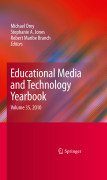
Educational media and technology yearbook v. 35, 2010
Orey, Michael
Jones, Stephanie A.
Branch, Robert Maribe
The evolution of educational technology has seen a shift from hardware and software to tactics and techniques, as the 2010 edition of the Educational Mediaand Technology Yearbook makes abundantly clear. As in previous years, it offers the reader a snapshot of the moment and a look ahead to issues most likely to shape the immediate future—an array as varied as the use of social networking sites in learning, new collaborations between media specialists and non-teaching school personnel, and the emerging discipline of Human Performance Technology. Here are ideas that are not only intellectually intriguing but also practical and practice-building, inspiring educators using computer technology tomove beyond traditional teaching roles toward learning design. Included in the 2010 Yearbook: Salient issues in learning, design, and technology, such as the critical part school leadership plays in instructors’ acceptance or rejection of technology, New trends in library and information science, including therole of school library media centers in preventing cyberbullying, This year’sleadership profiles: Jerrold Kemp, author of Designing Effective Instruction;W. Michael Reed, accomplished, dedicated, and recognized educator in instructional technology, A worldwide directory of current professional associations and organizations in learning design, technology, information, and library science, Up-to-date listings of graduate program in these fields, rated using a variety of criteria, Special mediagraphy section featuring journals, ERIC documents, and media-related publications in specialized areas, including distance education, simulation/virtual reality, artificial intelligence, special education, and professional development. Academics in learning design and technology,and information and library science will welcome the latest edition of the Educational Media and Technology Yearbook as a reference, idea book, and a panoramic study of where we are now." Only yearbook in the field of instructional technology Established publication with a 34 year history Partnership with the Association for Educational Communications and Technology Identifies leading educational programs using a variety of criteria INDICE: Preface.- Part I: Trends and Issues in Learning, Design, and Technology. 1. Introduction. 2. Understanding School Leaders’ Role in Teachers’ Adoption of Technology Integration Classroom Practices. 3. Issues and Trends in Instructional Technology: Growth and Maturation of Web-Based Tools in a Challenging Climate; Social Networks Gain Educators’ Attention. 4. Rapid Prototyping for Designing and Delivering Technology-based Lessons. 5. Theory-Based Evaluation of Instruction: Implications for Improving Student Learning Achievement inPostsecondary Education. 6. Developing technology fluency in community practice: Exploration of the 'Paintbrush' metaphor. 7. The Instructional and Learning Technologies Department (ILT) in the College of Education, Sultan Qaboos University. 8. Learning with Technology: Learner Voice and Agency. 9. Trends in Performance Improvement: Expanding the Reach of Instructional Design and Technology.- Part II: Trends and Issues in Library and Information Science. 10. Introduction. 11. School Library Media Specialists & School Counselors: Collaborative Partners to Expand Distance Education Opportunities for High School Students. 12. The Role of the School Library Media Center Program in the Education and Prevention of Cyberbullying. 13. E-Government, Government Documents, and School Libraries.- Part III: Leadership Profiles. 14. Introduction. 15. Jerrold Kemp: Designing Effective Instruction. 16. W. Michael Reed: At the Beginnings Using Computers in Education for Higher-Order Learning.- Part IV: Organizations and Associations in North America. 17. Introduction. 18. Worldwide List of Organizations in Learning, Design, Technology, Information or Libraries.- Part V: Graduate Programs. 19. Introduction. 20. Worldwide List of Graduate Programs in Learning, Design, Technology, Information or Libraries.- Part VI: Mediagraphy: Print and Non-Print Resources. 21. Introduction. 22. Mediagraphy. Index.
- ISBN: 978-1-4419-1502-3
- Editorial: Springer
- Encuadernacion: Cartoné
- Páginas: 330
- Fecha Publicación: 01/02/2010
- Nº Volúmenes: 1
- Idioma: Inglés
